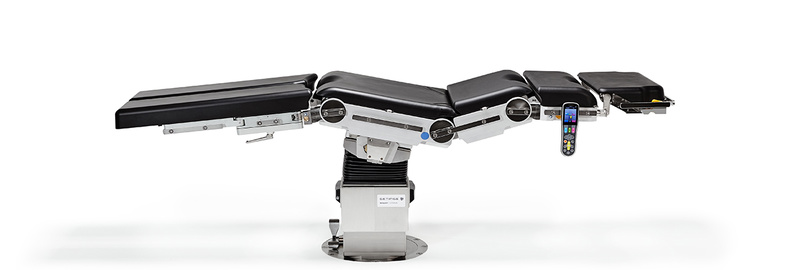Operating table systems are a well-established component of modern surgical infrastructure. Learn how their modular design meets critical medical requirements, enables efficient workflows, and proves to be a sustainable investment in today’s dynamic healthcare environment.
The first generation of operating table systems
The introduction of the first operating table system in 1964 marked a significant innovation: for the first time, the patient support surface could be used independently of the components underneath. Surgical teams were now able to exchange tabletops as needed and dock them to the column using a specially designed transporter – eliminating the need for dedicated tables for each surgical specialty. This innovation had a lasting impact on surgical practice. With model 1120, the Maquet brand was among the pioneers of this technology. The 1120 operating table system proved so advanced that it remained in use for decades.
A philosophy of flexibility and modularity
The modular concept of operating table systems remains highly effective today. Unlike older models that required a wide variety of specialized tabletops, newer systems such as Maquet Otesus and Maquet Magnus offer a universal tabletop and a 360° radiolucent carbon fiber tabletop optimized for minimally invasive procedures and intraoperative imaging. These surfaces are easy to swap, and in combination with a broad range of accessories, they allow quick adaptation to a wide variety of surgical requirements – making operating table systems broadly applicable across disciplines.
Operating table systems offer both stationary and mobile column options. Stationary columns are permanently floor-mounted and ideal for ORs requiring fixed installations, such as hybrid ORs. Mobile columns, in contrast, offer the flexibility to reposition the operating table for fine adjustments, cleaning, or special spatial requirements, especially when permanent floor installation is not feasible or desired. Mobile columns are battery-powered and require regular charging, unlike stationary models that are hardwired to the power grid.
How operating table systems meet the needs of modern ORs
Efficiency in the operating room has a direct impact on hospital economics. At the same time, the quality of procedures and the safety of both staff and patients are essential. Investments must also be future-proof and adaptable to rapid surgical advancements. Operating table systems fulfill all of these critical criteria precisely and comprehensively.
Optimizing patient workflow
Operating table systems enable the implementation of highly efficient workflows. Transportable tabletops allow patients to remain on the same surface from pre-op through the procedure to recovery, eliminating the need for time-consuming repositioning. Parallel workflows are also possible: while one patient is still in surgery, another can be prepared on a second tabletop. Compared to standard tables, this reduces turnover times and increases OR utilization.
Optimal access and ergonomics
Operating table systems support surgical teams with diverse positioning options that ensure optimal access to the surgical site, good visibility, and ergonomic working conditions. Precisely adjustable table movements allow exact patient positioning, and long longitudinal travel combined with carbon fiber components supports intraoperative imaging and diagnostics. Adjustable height further promotes ergonomic posture, helping staff work comfortably and with focus – especially during lengthy procedures.
Precise and safe patient positioning
These systems also fulfill the requirements for safe and comfortable patient positioning. Robust enough to accommodate all body types and weights, they ensure comfort through efficient pressure distribution. Wide ranges of adjustment for reverse or standard orientation, Trendelenburg, and tilt allow for improved surgical access and new opportunities to leverage gravity for optimal organ positioning during surgery.
Versatile and future-proof
The philosophy of modularity and flexibility makes operating table systems both versatile and future-proof. They can be adapted to accommodate new procedures – such as image-guided interventions in hybrid ORs – and expanded with additional components. The independent interchangeability of columns and tabletops also allows for step-by-step modernization without requiring complete system replacements. This enables hospitals to use their operating tables effectively and economically over the long term, without the need for constant reinvestment.
Conclusion
Operating table systems meet the critical demands of modern operating rooms in terms of workflow efficiency, access, ergonomics, patient positioning and safety. Their adaptability and modular design make them versatile, future-ready investments – essential for keeping pace with surgical innovation while ensuring long-term cost-effectiveness.
